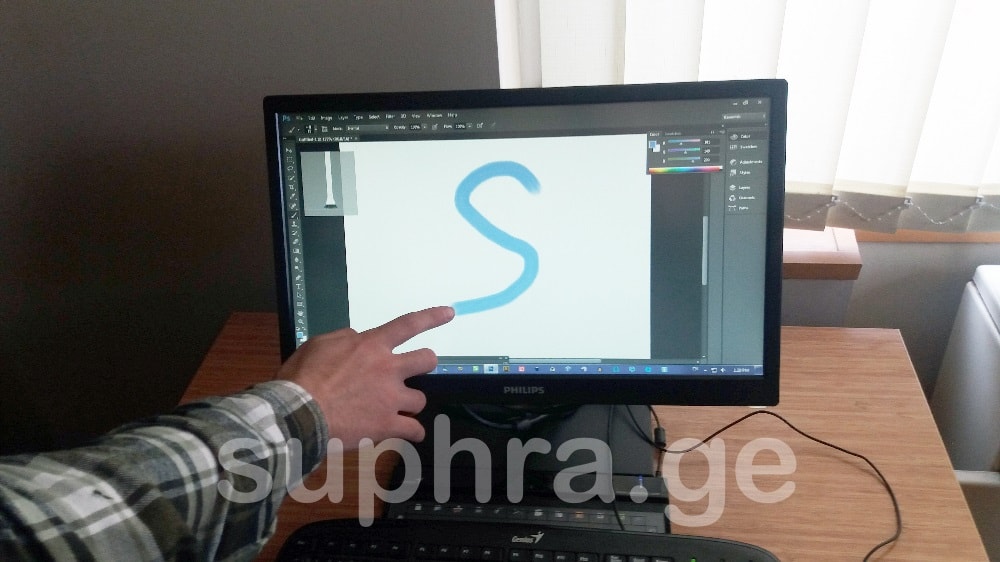Hardware
Touch Monitors
Touch Screens have become very commonplace in our daily lives: cell phones, ATM’s, kiosks, ticket vending machines and more all use touch panels to enable the user to interact with a computer or device without the use of a keyboard or mouse. But did you know there are several uniquely different types of Touch Screens? The five most common types are: 5-Wire Resistive, Surface Capacitive, Projected Capacitive, SAW (Surface Acoustic Wave), and Infrared.
Below is a basic description of each technology, and the advantages/disadvantages of each to help you decide which touch screen type is most appropriate for your needs:
5-Wire Resistive
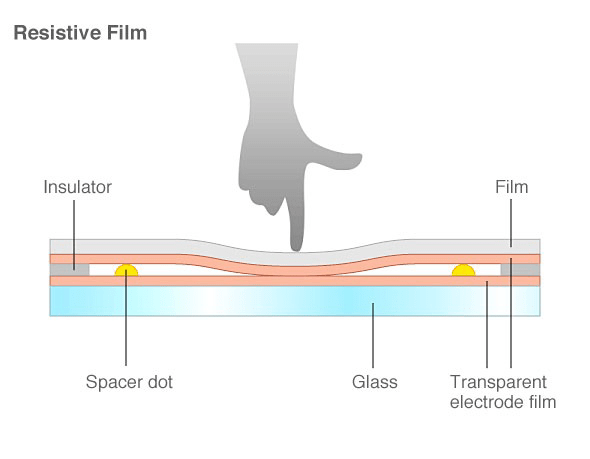 5-Wire Resistive Touch is the most widely used touch technology today. A resistive touch screen monitor is composed of a glass panel and a film screen, each covered with a thin metallic layer, separated by a narrow gap. When a user touches the screen, the two metallic layers make contact, resulting in electrical flow. The point of contact is detected by this change in voltage.
5-Wire Resistive Touch is the most widely used touch technology today. A resistive touch screen monitor is composed of a glass panel and a film screen, each covered with a thin metallic layer, separated by a narrow gap. When a user touches the screen, the two metallic layers make contact, resulting in electrical flow. The point of contact is detected by this change in voltage.
- Can be activated with virtually any object (finger, stylus, gloved hand, pen, etc.).
- Has tactile feel.
- Lowest cost touch technology.
- Low power consumption.
- Resistant to surface contaminants and liquids (dust, oil, grease, moisture).
- Lower image clarity compared to other touch technologies.
- Outer polyester film is vulnerable to damage from scratching, poking and sharp objects.
Surface Capacitive
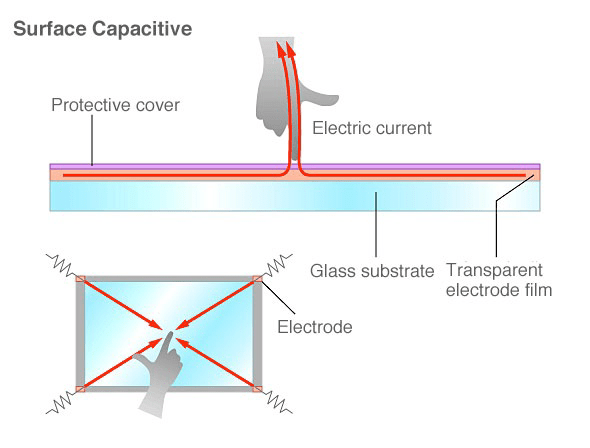 Surface Capacitive are the second most popular type of touch screens on the market. In a surface capacitive touch screen monitor, a transparent electrode layer is placed on top of a glass panel, and covered by a protective cover. When an exposed finger touches the monitor screen, it reacts to the static electrical capacity of the human body; some of the electrical charge transfers from the screen to the user. This decrease in capacitance is detected by sensors located at the four corners of the screen, allowing the controller to determine the touch point. Capacitive touch screens can only be activated by the touch of human skin or a stylus holding an electrical charge.
Surface Capacitive are the second most popular type of touch screens on the market. In a surface capacitive touch screen monitor, a transparent electrode layer is placed on top of a glass panel, and covered by a protective cover. When an exposed finger touches the monitor screen, it reacts to the static electrical capacity of the human body; some of the electrical charge transfers from the screen to the user. This decrease in capacitance is detected by sensors located at the four corners of the screen, allowing the controller to determine the touch point. Capacitive touch screens can only be activated by the touch of human skin or a stylus holding an electrical charge.
- Better image clarity than Resistive Touch.
- Durable screen.
- Excellent resistance to surface contaminants and liquids (dust, oil, grease, water droplets).
- High scratch resistance.
- Requires bare finger or capacitive stylus for activation.
- Sensitivity to EMI/RFI (EMI - Electromagnetic interference. RFI - Radio frequency interference).
Projected Capacitive
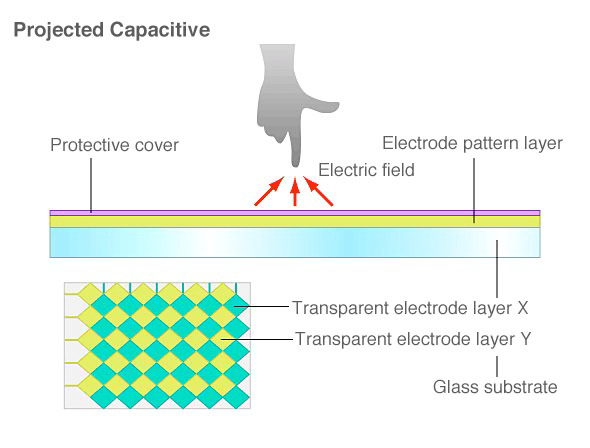 Projected Capacitive is similar to Surface Capacitive, but it offers two primary advantages: in addition to a bare finger, it can also be activated with surgical gloves or thin cotton gloves; and it enables multi-touch activation (simultaneous input from two fingers). A projected capacitive is composed of a sheet of glass with embedded transparent electrode films and an IC chip, which creates a three-dimensional electrostatic field. When a finger comes into contact with the screen, the ratios of the electrical currents change and the computer is able to detect the touch points.
Projected Capacitive is similar to Surface Capacitive, but it offers two primary advantages: in addition to a bare finger, it can also be activated with surgical gloves or thin cotton gloves; and it enables multi-touch activation (simultaneous input from two fingers). A projected capacitive is composed of a sheet of glass with embedded transparent electrode films and an IC chip, which creates a three-dimensional electrostatic field. When a finger comes into contact with the screen, the ratios of the electrical currents change and the computer is able to detect the touch points.
- Excellent image clarity.
- More resistant to scratching than Surface Capacitive.
- Resistant to surface contaminants and liquids (dust, oil, grease, moisture).
- Multi-touch (two-touch).
- Sensitive to EMI/RFI.
- Must be activated via exposed finger, or thin surgical or cotton gloves.
SAW (Surface Acoustic Wave)
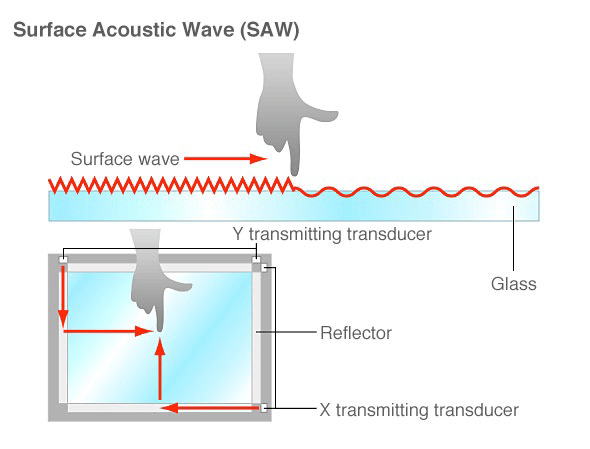 SAW (Surface Acoustic Wave) touch screen monitors utilize a series of piezoelectric transducers and receivers along the sides of the monitor’s glass plate to create an invisible grid of ultrasonic waves on the surface. When the panel is touched, a portion of the wave is absorbed. This allows the receiving transducer to locate the touch point and send this data to the computer. SAW monitors can be activated by a finger, gloved hand, or soft-tip stylus. SAW monitors offer easy use and high visibility.
SAW (Surface Acoustic Wave) touch screen monitors utilize a series of piezoelectric transducers and receivers along the sides of the monitor’s glass plate to create an invisible grid of ultrasonic waves on the surface. When the panel is touched, a portion of the wave is absorbed. This allows the receiving transducer to locate the touch point and send this data to the computer. SAW monitors can be activated by a finger, gloved hand, or soft-tip stylus. SAW monitors offer easy use and high visibility.
- Excellent image clarity.
- Even better scratch resistance than capacitive.
- High “touch-life”.
- Will not activate with hard items (pen, credit card, or fingernail).
- Water droplets may cause false triggering.
- Solid contaminants on the screen can create non-touch areas until they are removed.
Infrared
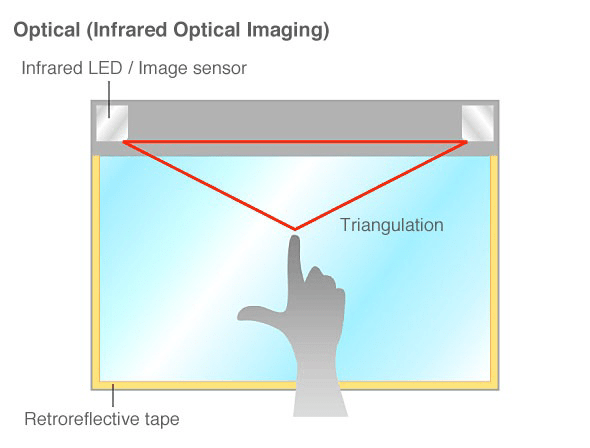 Infrared touch screen monitors do not overlay the display with an additional screen or screen sandwich. Instead, infrared monitors use IR emitters and receivers to create an invisible grid of light beams across the screen. This ensures the best possible image quality. When an object interrupts the invisible infrared light beam, the sensors are able to locate the touch point.
Infrared touch screen monitors do not overlay the display with an additional screen or screen sandwich. Instead, infrared monitors use IR emitters and receivers to create an invisible grid of light beams across the screen. This ensures the best possible image quality. When an object interrupts the invisible infrared light beam, the sensors are able to locate the touch point.
- Highest image clarity and light transmission of all touch technologies.
- Unlimited “touch-life”.
- Impervious to surface scratches.
- Accidental activation may occur because the infrared beams are actually above the glass surface.
- Dust, oil, or grease buildup on screen or frame could impede light beam causing malfunction.
- Sensitive to water, snow, rain.
- May be sensitive to ambient light interference.
- Higher cost.
Manufacturers
Resistive
Surface Capacitive
- 3M
- Alps Electric Corporation
- Apex Material Technology (AMT)
- Atmel
- Cirque
- Cypress
- Synaptics
- Touch International
Projected Capacitive
Infrared
Surface acoustic wave (SAW)
Alternative To Touch Monitors
Touch monitors make it comfortable for waiters/waitresses to work. They make it easier to make orders, therefore, speed of working increases. However, touch monitors are things of luxury for restaurants, because of their high price. Touch monitors assembled in Georgia are way cheaper. They look like this: